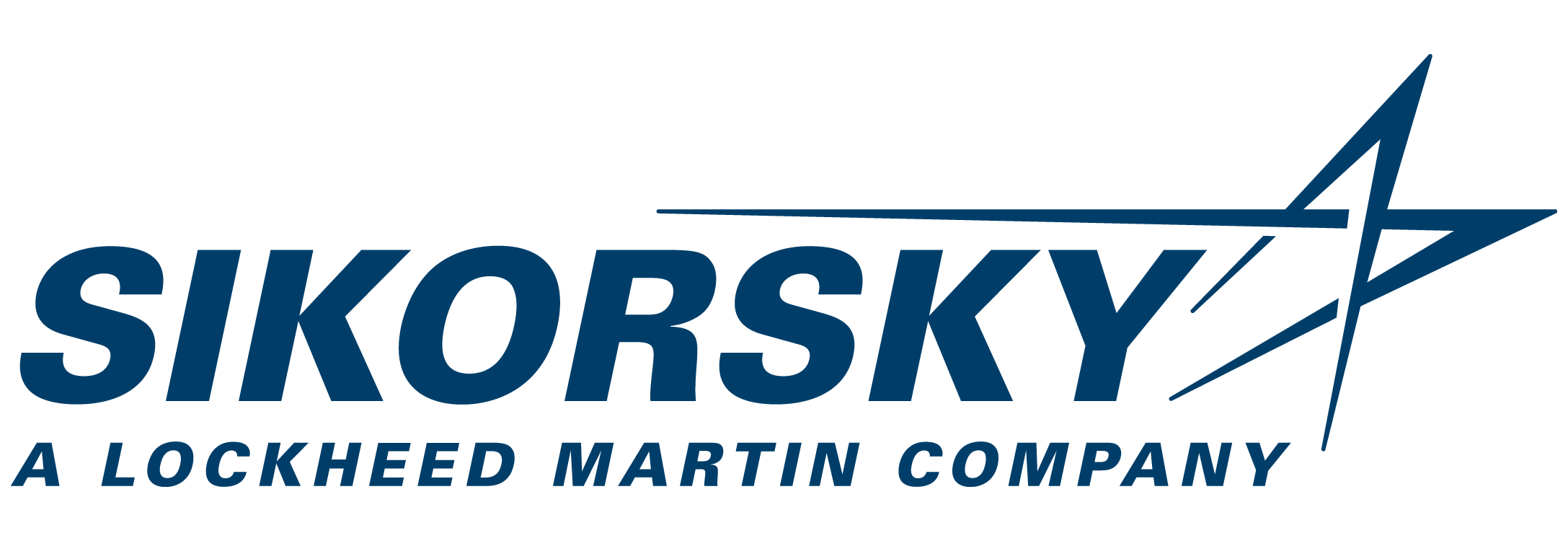This Naval Helicopter History Timeline is sourced using historical data and pictures from “THE NAVAL HELICOPTER-HIGHLIGHTS IN NAVAL HELICOPTER HISTORY,” written by CAPT Vincent C. Secades USN (Ret), Published by Naval Helicopter Association, Coronado, California, 2nd Edition June 2012.
NAVAL HELICOPTER HISTORY TIMELINE 1940 till 1950
Commander D. Royce was Designated to Represent the Navy
April 23, 1940-Commander D. Royce was designated to represent the Navy on an Army Air Corps Evaluation Board for rotary-wing aircraft. This board was established incidental to legislation directing the War Department to undertake governmental development of rotary-wing aircraft.
XSOC-1 Conducted Successful Operations
May 20,1940-The Commanding Officer of the destroyer Noa (DD 343) reported on successful operations conducted off the Delaware Capes in which an XSOC-1, piloted by Lieutenant G. L. Heap, was hoisted over the side for takeoff and was recovered by the ship while underway. As an epilogue to preliminary operations conducted at anchor on 15 May, Lieutenant Heap made an emergency flight transferring a stricken seaman from the Noa in Harbor of Refuge, Del., to the Naval Hospital, Philadelphia.
Igor Ivanovich Sikorsky - Designed and Flew the FIRST successful United States Helicopter
May 24 1940- Igor Ivanovich Sikorsky – (05/25/1889 – 10/26/1972) – Designed and flew the FIRST successful United States helicopter, the Vought-Sikorsky 300 (VS-300).
U.S. Army Awarded Sikorsky Aircraft a Contract to Build the XR-4 Single-Main-Rotor and Tail Rotor Helicopter
December 17, 1940. – The U.S. Army awarded Sikorsky Aircraft a contract to build the XR-4 single-main-rotor and tail rotor helicopter prototype. Sikorsky would use this configuration in all his future helicopter designs. The XR-4 first flew on 13 January 1942.
U.S. Coast Guard Tranferred to the Navy Department
November 1, 1941. – In view of the deteriorating diplomatic situation and anticipating the break of hostilities in both, the Atlantic and the Pacific theaters, President Franklin D. Roosevelt issued an executive order transferring operational control of the U.S. Coast Guard to the Navy Department.
Sikorsky Offered a XR-4 Flight Demonstration for the Army and Representatives of the U.S. Navy, Coast Guard, and the Royal Navy. USCG
April 20, 1942. – Sikorsky offered a XR-4 flight demonstration for the Army and representatives of the U.S. Navy, Coast Guard, and the Royal Navy. USCG CDR Watson A. Burton, Commanding Officer of the New York Coast Guard Air Station, Floyd Bennett Field, Brooklyn, NY, and CDR William J. Kossler, who was serving as Chief of the Aviation Engineering Division at Coast Guard Headquarters, witnessed the demonstration. They agreed that the helicopter could meet the requirements of a rescue vehicle and proposed that three helicopters be procured for test and evaluation. Their proposal was immediately rejected.
CDR Kossler, in his Quest to Bring to Fruition the Naval Helicopter
May 1942. – CDR Kossler, in his quest to bring to fruition the naval helicopter, arranged for his protégée, LCDR Frank A. Erickson, an experienced seaplane pilot and a fervent helicopter advocate, to be assigned as Executive Officer of the New York Coast Guard Air Station. With their shared enthusiasm for the helicopter as a rescue vehicle, Kossler wanted to bring Erickson close to the Sikorsky factory.
President Ordered that an Air Medal be Established
May 11, 1942-The President ordered that an Air Medal be established for award to any person who, while serving in any capacity in or with the Army, Navy, Marine Corps, or Coast Guard after 8 September 1939, distinguishes or has distinguished himself by meritorious achievement while participating in aerial flight.
LCDR Erickson Visited the Sikorsky Plant in Connecticut
June 26, 1942. – LCDR Erickson visited the Sikorsky plant in Connecticut and inspected the XR-4 development program. Three days later he submitted a report to Headquarters recommending the procurement of helicopters for convoy antisubmarine patrol and search and rescue duty. Knowing that the Navy was very concerned with the convoy losses in the Atlantic caused by German submarines, Erickson placed emphasis on the helicopter antisubmarine role.
The Bureau of Aeronautics issued a Planning Directive for the Procurement of four Sikorsky helicopters
July 24, 1942. – The Bureau of Aeronautics issued a Planning Directive for the procurement of four Sikorsky helicopters, one YR-4 and three XR-6s, for evaluation by the Navy and Coast Guard. CDR Kossler convinced the Commandant of the Coast Guard, ADM Russell R. Waesche, to obtain authorization from ADM Ernest J. King, Chief of Naval Operations, to establish a Coast Guard helicopter test and evaluation program.
Commander in Chief U.S. Fleet Directed that an Aircraft Experimental and Developmental Squadron be Established
August 13, 1942-The Commander in Chief U.S. Fleet directed that an Aircraft Experimental and Developmental Squadron be established about 30 September 1942 at NAS Anacostia. This squadron, which replaced the Fleet Air Tactical Unit, was to conduct experiments with new aircraft and equipment in order to determine their practical application and tactical employment.
The V-173, a full-scale model of a Fighter Aircraft with an almost Circular Wing, Made its First Flight
November 23, 1942-The V-173, a full-scale model of a fighter aircraft with an almost circular wing, made its first flight at the Vought-Sikorsky plant, Stratford, Conn. A military version of this aircraft, the XF5U-1, was constructed later but never flown.
Bell Aircraft Corporation Developed the First Helicopter to Fly with a Teetering Semi-Rigid Rotor System
December 18, 1942- Lawrence “Larry” Bell – (04/05/1894 – 10/20/1956) – Bell Aircraft Corporation developed the first helicopter to fly with a teetering semi-rigid rotor system with stabilizer bar and ushered in an age of economical, easily produced helicopter models.
ADM King Issued a Letter to the Bureau of Aeronautics Directing the Development and Evaluation of Helicopters
February 15, 1943. – ADM King issued a letter to the Bureau of Aeronautics directing the development and evaluation of helicopters deployed aboard merchant ships for antisubmarine patrol duty. It assigned responsibility to the Coast Guard for the testing and evaluation of helicopters. On 4 May a Combined Board for the Evaluation of the Ship-Based Helicopter in Antisubmarine Warfare was formed.
The Naval Photographic Science Laboratory was Established at NAS Anacostia
February 24, 1943-The Naval Photographic Science Laboratory was established at NAS Anacostia under the direction of the Bureau of Aeronautics to provide photographic services to the Navy and to develop equipment and techniques suitable for fleet use.
Evaluation of the Helicopter in Anti-Submarine Operations
May 4, 1943-To expedite the evaluation of the helicopter in antisubmarine operations, the Commander in Chief, U.S. Fleet directed that a “joint board” be formed with representatives of the Commander in Chief, U.S. Fleet; the Bureau of Aeronautics; the Coast Guard; the British Admiralty and the Royal Air Forces. The resulting Combined Board for the Evaluation of the Ship-Based Helicopter in Anti-Submarine Warfare was later expanded to include representatives of the Army Air Forces, the War Shipping Administration and the National Advisory Committee for Aeronautics.
The Army Conducted the First Sea Trials of the XR-4 aboard the Merchant Tanker Bunker Hill
May 7, 1943. – The Army conducted the first sea trials of the XR-4 aboard the merchant tanker Bunker Hill, with Captain Frank Gregory at the controls. The Maritime Commission sponsored this demonstration, conducted in the Long Island Sound. Captain Gregory circled and landed aboard the ship about fifteen times.
LCDR Erickson began Helicopter Flight Training in the XR-4 at the Sikorsky Plant in Connecticut
June 1943. – LCDR Erickson began helicopter flight training in the XR-4 at the Sikorsky plant in Connecticut. He soloed after three hours of dual flight training with Sikorsky’s chief test pilot Les Morris, thus becoming Coast Guard helicopter pilot number one.
LCDR Erickson Submitted Proposal on the Helicopter’s Antisubmarine Potential.
June 10, 1943. – LCDR Erickson submitted another proposal, this time placing all the emphasis on the helicopter’s antisubmarine potential. He recommended that helicopters be equipped with radar and dunking sonar to become “the eyes and ears of the convoy escorts.”
The Bureau of Aeronautics Placed an Order for 44 R-5s (Navy designation HO2S-1)
June 22, 1943. – The Bureau of Aeronautics placed an order for 44 R-5s (Navy designation HO2S-1), a new Sikorsky design twice as big as the R-4. By the time the first HO2S-1, was accepted in December 1945, the war had ended. These helicopters were assigned to NAS New York and USCG Air Station, Elizabeth City, SC.
The Navy Accepted its First Helicopter, a Sikorsky YR-4B, Navy designation XHNS-1, BuNo 46445
October 16, 1943. – The Navy accepted its first helicopter, a Sikorsky YR-4B, Navy designation XHNS-1, BuNo 46445, at Bridgeport, Connecticut. LCDR Erickson flew the one-hour acceptance flight. CDR Charles T. Booth, USN, went to Bridgeport to qualify as a helicopter pilot and to fly the XHNS-1 to the Naval Air Test Center (NATC), NAS Patuxent River, MD. CDR Booth was the first U.S. Navy Officer to become qualified to fly helicopters.
LTJG Steward R. Graham, USCG, Completed Helicopter Flight Training at the Sikorsky Plant
October 20, 1943. – LTJG Steward R. Graham, USCG, completed helicopter flight training at the Sikorsky plant, soloing after three and a half hours of dual instruction. LTJG Graham became USCG helicopter pilot number two. LCDR Erickson was his flight instructor. Graham would become the lead test pilot in the development of the helicopter as an ASW platform.
CDR Charles T. Booth Delivered the First XHNS-1 to NAS Patuxent River
October 22, 1943. – CDR Charles T. Booth delivered the first XHNS-1 to NAS Patuxent River. He established and led a helicopter flight test facility at NATC. The Army transferred two additional YR-4Bs to the Navy. In time, a total of 20 YR-4Bs from the Army contract of 100 were transferred to the Navy. According to its records, between October 1943 and December 1944 the U.S. Navy accepted 68 YR-4Bs (HNS-1s). They were powered with the R-550 radial engine, its various versions developing between 180 and 200 hp.
The New York Coast Guard Air Station was Designated the First U.S. Naval Helicopter Training Base
November 19, 1943. – The New York Coast Guard Air Station was designated the first U.S. naval helicopter training base, newly promoted CDR Erickson commanding. Erickson began to train Coast Guard, Navy, Army Air Corps, and British helicopter pilots.
LCDR John M. Miller, USNR, Soloed the HNS-1, Becoming U.S. Navy Helicopter Pilot Number Two
December 5, 1943. – LCDR John M. Miller, USNR, soloed the HNS-1, becoming U.S. Navy helicopter pilot number two. CDR Erickson was his flight instructor. A few days later the Navy conducted its first HNS-1 shipboard operational test. LCDR Miller landed aboard the British freighter M. V. Daghestan in the Long Island Sound.
Chief of Naval Operations Directed the Separation of the Helicopter Test and Development Functions from the Pilot Training Function.
December 18, 1943. – Based on the results of this test, the Chief of Naval Operations directed the separation of the helicopter test and development functions from the pilot training function. He further directed that, effective 1 January 1944, the Coast Guard establish a helicopter pilot training program at Floyd Bennett Field, under the direction of the Deputy Chief of Naval Operations (Air). The directive established the criteria that after 25 hours of dual and solo flight time, a fixed wing pilot was qualified as a helicopter pilot. It further stated than, as of the date of the directive, three Coast Guard and two Navy officers had qualified as helicopter pilots. These pilots were: LCDR Frank A. Erickson, LTJG Steward R. Graham, and LT A. N. Fisher from the Coast Guard, and CDR Charles T. Booth and LCDR John M. Miller from the Navy. These early helicopter pilots did not have a formal Navy training program to follow, or an established procedure to record and preserve their helicopter pilot qualifications. In fact, their training consisted on a few hours of dual flight instruction, enough to make them safe-for-solo. From then on they gained their flying proficiency while performing their assigned flying duties. They were never placed in the list of designated helicopter pilots. From its beginning, the Navy considered helicopter rating as a postgraduate qualification, and only Naval Aviators were sent to helicopter training. This policy continued until 1954.
The Navy Signed a Contract For Frank Piasecki’s Single XHRP-1 Prototype
January 1, 1944. – The Navy signed a contract with P-V Engineering Forum, Frank Piasecki’s emerging enterprise, for the building of a single XHRP-1 prototype. This was the first twin-rotor helicopter in the tandem configuration built in the U.S. The XHRP-X, a technology demonstrator, first flew on 7 March 1945. The XHRP-1 evaluation was very successful, and the Navy quickly ordered production of twenty HRP-1s, nicknamed the “Flying Banana.”
CDR Erickson performed the First Recorded Helicopter Mission of Mercy
January 3, 1944. – CDR Erickson performed the first recorded helicopter mission of mercy when he flew an HNS-1 through a winter blizzard to deliver a cargo of blood plasma from Manhattan, NY, to the Hospital at Sandy Hook, NJ, to treat over 100 sailors injured in explosions aboard the destroyer USS Turner. This event helped to reverse the perception of helicopters as impractical machines.
The First Atlantic Convoy that Used the New Antisubmarine Helicopter Patrol Capability
January 6, 1944. – The first Atlantic convoy that used the new antisubmarine helicopter patrol capability sailed from New York to Liverpool, UK, with two HNS-1 helicopters and three pilots, U.S. Navy LCDRs James Klopp and John Miller and USCG LTJG StewartGraham embarked. The first sortie at sea was flown from Daghestan by LTJG Graham on 16 January, a 30 minutes flight. With the support of CAPT Kossler and ADM Waesche, CDR Erickson had been able to sell the Navy on the concept of using the helicopter in the convoy antisubmarine patrol role.
First Detection of a Submerged Enemy Submarine by the Use of MAD Gear
February 24, 1944-The first detection of a submerged enemy submarine by the use of MAD gear was made by Catalinas of VP-63, on a MAD barrier patrol of the approaches to the Strait of Gibraltar. They attacked the U-761 with retrorockets, and with the assistance of two ships and aircraft from two other squadrons, sank it.
LCOL Desmond E. Canavan, USMC, Flew his First Helicopter Dual Flight
March 30, 1944. – LCOL Desmond E. Canavan, USMC, serving as test pilot at NATC, Patuxent River, flew his first helicopter dual flight in the XHNS-1 BuNo 39034. After twelve dual flights with LCDR John Miller, LCOL Canavan soloed the XHNS-1 on 3 November 1944, thus becoming the first Marine pilot to obtain a helicopter qualification.
Air-Sea Rescue Squadrons (VH) were Formed in the Pacific Fleet
April 15, 1944-Air-Sea Rescue Squadrons (VH) were formed in the Pacific Fleet to provide rescue and emergency services as necessary in the forward areas. Prior to this time the rescue function was performed as an additional duty by regularly operating patrol squadrons
Helicopter Designation Letters Changed
May 13, 1944-To distinguish between fixed and rotary wing heavier-than-aircraft, the helicopter class designation VH plus a mission letter (i.e. VHO for observation and VHN for training) was abolished and helicopters were established as a separate type designated H. The previous mission letters thus became classes designated O, N, and R for observation, training and transport respectively.
Development of a Automatic Pilot Installation in a HNS-1 Helicopter
May 17, 1944-The Bureau of Aeronautics authorized CGAS Floyd Bennett Field to collaborate with the Sperry Gyroscope Company in making an automatic pilot installation in a HNS-1 helicopter.
USCGC Cobb (WPG-181), the First U.S. Helicopter Carrier, Began Underway Operations in the Long Island Sound
June 1944. – USCGC Cobb (WPG-181), the first U.S. helicopter carrier, began underway operations in the Long Island Sound. USCGC Cobb was a modified old passenger ship. Excessive maintenance costs drove the Coast Guard to decommission her on 31 January 1946.
Parachute Experimental Division was Established at Lakehurst
June 29, 1944-The Parachute Experimental Division was established at Lakehurst, N.,J., for research, development, and testing of parachutes and survival gear.
CDR Erickson Began Testing a Bomb-Loading Electric Hoist Installed in an HNS-1
August 11, 1944. – CDR Erickson began testing a bomb-loading electric hoist installed in an HNS-1, the first rescue hoist installed in a helicopter. After four days of testing over Jamaica Bay, its feasibility was clearly demonstrated, but the electric motor proved to be too weak and slow. Erickson switched to a hydraulic motor that could lift 400 pounds at two and a half feet per second. During new testing six weeks later the hydraulic system performed very satisfactorily, leading to its adoption for service use.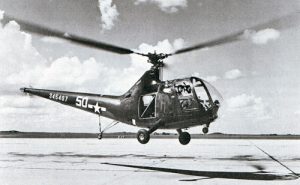
Sperry Gyroscope Company Submitted a Brief Report On Automatic Flight Control System for a Helicopter
August 11, 1944-Dr. M. F. Bates of the Sperry Gyroscope Company submitted a brief report of the trial installation and flight test of a helicopter automatic pilot (cyclic pitch control) in an HNS-1 at CGAS Floyd Bennett Field.
New Bureau of Aeronautics Color Specification Went into Effect
October 7, 1944-A new Bureau of Aeronautics color specification went into effect which provided seven different color schemes for aircraft depending upon design and use. The most basic change was the use of glossy sea blue all over on carrier based aircraft and on seaplane transports, trainers and utility aircraft. The basic non-specular camouflage color scheme, semigloss blue above and nonspecular white below, was to be applied to patrol and patrol bombing types and to helicopters. For antisubmarine warfare, two special camouflage schemes–gray on top and sides and white on bottom, or white all over–were prescribed with the selection dependent upon prevailing weather conditions (this had been used by COMNAVAIRLANT since 19 July 1943). All aluminum was to be used on landplane transports and trainers and landplane and amphibian utility aircraft. Orange-yellow was to be used upon target-towing aircraft and primary trainers. Another new scheme, glossy red, was specified for target drones.
Recognition of the Future Importance of Turbojet and Turboprop Powerplants
November 6, 1944-Recognition of the future importance of turbojet and turboprop powerplants led the Bureau of Aeronautics to request the Naval Air Material Center to study requirements for a laboratory to develop and test gas-turbine powerplants. This initiated action which led to the establishment of the Naval Air Turbine Test Station, Trenton, N.J.
Three Evacuation Squadrons (VE) were Established in the Pacific
December 12, 1944-Three Evacuation Squadrons (VE) were established in the Pacific from Air Sea Rescue Squadron elements already providing evacuation services.
The Navy Accepted Three Prototypes of the Sikorsky XR-6, Navy Designation XHOS-1
September 1944. – The Navy accepted three prototypes of the Sikorsky XR-6, Navy designation XHOS-1. Under Sikorsky license, Nash-Kelvinator in Detroit began production of the HOS-1 in 1945. The Navy accepted 36 helicopters from Nash-Kelvinator before all war production contracts were cancelled shortly after V-J Day, 2 September 1945.
The Tandem Rotor XHRP-X Transport Helicopter Made its First Flight
March 7, 1945-The tandem rotor XHRP-X transport helicopter, built under Navy contract by P-V Engineering Forum made its first flight at the contractor’s plant at Sharon Hill, Pennsylvania with Frank N. Piasecki as pilot and George N. Towson as copilot.
CDR Erickson Reported that a Dipping Sonar Suspended from a XHOS-1 Helicopter Performed Successfully
March 7, 1945. – CDR Erickson reported that a dipping sonar suspended from a XHOS-1 helicopter performed successfully. LT Steward Graham conducted the test. He soon became the principal test pilot developing helicopter antisubmarine equipment and tactics.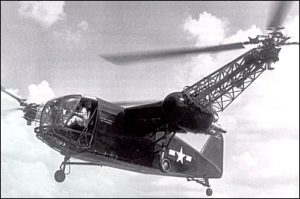
Patrol Squadrons of Fleet Air Wing 1 Conducted Long-Range Antishipping Search
March 18, 1945 June 21,1945-Patrol squadrons of Fleet Air Wing 1, based on seaplane tenders at Kerama Retto, conducted long-range antishipping search over the East China Sea to protect assault forces from enemy surface force interference, flew antisubmarine patrols in the immediate area, and provided air-sea rescue services for carrier operations from D minus 1 day to the end of the campaign.
Navy Awarded McDonnell Aircraft a Contract to Build a Prototype of the XHJD-1 Whirlaway helicopter
March 23, 1945. – The Navy awarded McDonnell Aircraft Co. a contract to build a prototype of the XHJD-1 Whirlaway helicopter, to be used as a research platform. Using the side-by-side design, the Whirlaway was the first twin-engine, twin-rotor helicopter built in the U.S. After completing a 250 hours technology development program, the Whirlaway, was donated to the National Air and Space Museum in 1951.
LT August Kleisch, USCG Helicopter Pilot Number 5, Flying an HNS-1 helicopter, Completed a Three-Day-Long Rescue
May 2, 1945. – LT August Kleisch, USCG helicopter pilot number 5, flying an HNS-1 helicopter, completed a three-day-long rescue of eleven Canadian airmen marooned after a plane crash in northern Labrador. The event brought worldwide attention to the novel new aircraft with a unique capability.
Victory in Europe V-E Day Declared by The President
May 8, 1945-V-E Day–The President proclaimed the end of the war in Europe
President Harry S. Truman Issued an Executive Order Returning Control of the U.S. Coast Guard to the Treasury Department.
January 1, 1946. – On this day President Harry S. Truman issued an executive order returning control of the U.S. Coast Guard to the Treasury Department. However, the Coast Guard remained involved in the test and development of the helicopter as an ASW platform until 1951.
Operation Frostbite
March 1, 1946-Operation Frostbite–Midway with elements of Air Group 74 on board, and accompanied by three destroyers, left Norfolk under command of Rear Admiral John H. Cassady to conduct cold weather tests in Davis Strait. In the period 7-22 March, these units operated as a carrier task force off the coast of Labrador and above the Arctic Circle, conducting flight operations with World War II type aircraft and the newer F8F Bearcat, the combination prop and jet FR-1 Fireball, and the HNS-1 helicopter.
The XHJD-1, the First Twin Engine Helicopter, made a Hovering Flight
March 25, 1946-The XHJD-1, the first twin engine helicopter, made a hovering flight. Designed for the Navy by the McDonnell Aircraft Corporation, this helicopter was intended for experimental use in a flight development program and for tactical use in utility and air-sea rescue operations.
The Navy Successfully Completed the Operational Test of the Hayes XCF Dipping Sonar
May 22, 1946. – The Navy successfully completed the operational test of the Hayes XCF dipping sonar off the coast of Key West, FL. LT Steward Graham, USCG, flew a HO2S-1 with the sonar suspended underneath. Using a captured German submarine as the target, the sonar provided good detection ranges and accurate bearings.
A Sikorsky S-51 Civilian Helicopter, Performed Plane Guard Duties aboard USS Franklin D. Roosevelt (CVA-42)
Summer of 1946. – A Sikorsky S-51 civilian helicopter, piloted by Dimitri “Jimmy” Viner, Igor Sikorsky’s nephew, performed plane guard duties aboard USS Franklin D. Roosevelt (CVA-42) during a Caribbean cruise. Jimmy Viner rescued several pilots that had to ditch near the carrier, and one sailor that was blown off the flight deck. These incidents sold the Navy on the concept of helicopter plane guard during carrier flight operations.
Navy Established a New Squadron, VX-3, at NAS New York
July 1, 1946. – The Navy established a new squadron, VX-3, at NAS New York with the mission to train helicopter pilots and other personnel and to develop the tactical employment of helicopters. VX-3 immediately resumed the training of helicopter pilots, a duty previously assigned to the Coast Guard. On 10 September of that year, VX-3 moved to NAS Lakehurst, NJ, and continued training pilots.
Sabena Airlines DC-4 Helicopter Rescue near Gander, Newfoundland
September 18, 1946. – A Sabena Airlines DC-4 crashed near Gander, Newfoundland, on a flight from Brussels to New York. Seventeen people survived the crash, but they were trapped in a heavily wooded area in the middle of a large bog. The survivors, many seriously injured, would not survive over-land evacuation. In less than 48 hours two helicopters, an HNS-1 and an HOS-1, were disassembled at Floyd Bennett Field, NY, loaded on a C-54, flown to the Gander Airport, reassembled and tested. The pilots, CDR Frank Erickson, LT Stewart Graham, LT Walter Bolton, and LT August Kleisch, made repeated flights between the crash site and Gander Lake to extract all 17 survivors. This event brought international recognition to the helicopter rescue capabilities.
In Preparation for Operation High Jump, the First Post-War Antarctic Expedition
September 1946. – In preparation for Operation High Jump, the first post-war Antarctic expedition, the Navy bought four off-the-shelf S-51s, Navy designation HO3S-1. They were assigned to VX-3. .
The Navy Receives First HO3S-1 Helicopters with Blade-Folding Rotors
November 1946. – The Navy began to receive the first of the new HO3S-1 helicopters equipped with blade-folding rotors and externally mounted res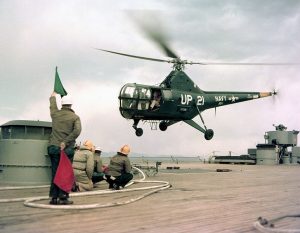 cue hoists. They were based on several warship classes, mainly the aircraft carriers, seaplane tenders, icebreakers, cruises, and battleships. The HO3S-1 was the first Navy helicopter to replace some fixed wing aircraft in the fleet. By late 1949 the HO3S-1 had totally replaced the small seaplanes carried by cruises and battleships.
cue hoists. They were based on several warship classes, mainly the aircraft carriers, seaplane tenders, icebreakers, cruises, and battleships. The HO3S-1 was the first Navy helicopter to replace some fixed wing aircraft in the fleet. By late 1949 the HO3S-1 had totally replaced the small seaplanes carried by cruises and battleships.
First Helicopter to Fly Over the Atlantic
December 25, 1946. – An HO3S-1 piloted by LCDR Walter M. Sessums became the first helicopter to fly over the Antarctic.
New Specification for Aircraft Color
January 2, 1947-A new specification for aircraft color was issued providing for the use of glossy sea blue on all shipboard and water based aircraft and all helicopters; aluminum was retained for landplane transports, utility planes and advanced training planes; and glossy orange yellow was similarly retained for primary trainers. Special color schemes included land camouflage (olive drab above and light gray below) for Marine observation planes; glossy insignia red for target drones; target towing aircraft were to have glossy orange yellow wings, and glossy sea blue fuselage with glossy insignia red wing bands and rudder.
Navy Sikorsky HO3S-1 Rescues Pilot in the Atlantic
February 9, 1947. – A Sikorsky HO3S-1 that was being evaluated by CTF-2 in the Atlantic picked up LT Frank A. Shields, a SB2C pilot that had to ditch near the carrier USS Leyte, and deposited him safely on the carrier deck in just six minutes.
The Adaptation of the Helicopter to Amphibious Warfare was Initiated
July 24, 1947-The adaptation of the helicopter to amphibious warfare was initiated when the Chief of Naval Operations established a requirement for a type capable of transporting assault troops from an escort carrier and setting them down ashore along with their necessary combat equipment and supplies.
The Army Transferred Ten Bell Model 47 Helicopters to the Navy
February 1947. – The Army transferred ten Bell Model 47 helicopters to the Navy for evaluation as HTL-1 trainers. Subsequent buys of more advance models increased the total Navy acquisition of HTLs to 187. Starting in April 1948, some were assigned to HU-1 and HU-2 and used aboard icebreakers. Some were use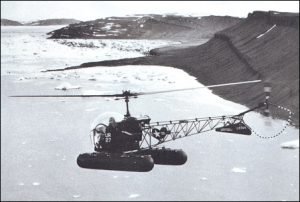 d by the Marines in liaison, transport, and casualty evacuation roles. The majority was used as primary trainers in HU-2, and later in HTU-1 at Ellyson Field, Pensacola. They remained in service as primary trainers until 16 May 1968.
d by the Marines in liaison, transport, and casualty evacuation roles. The majority was used as primary trainers in HU-2, and later in HTU-1 at Ellyson Field, Pensacola. They remained in service as primary trainers until 16 May 1968.
Marine Helicopter Experimental Squadron One, HMX-1, was Established
December 1, 1947. – Marine Helicopter Experimental Squadron One, HMX-1, was established at MCAS Quantico, VA, under the command of Colonel Edward C. Dyer. The new squadron’s mission was to develop techniques and tactics for the use of helicopters in amphibious operations. By February 1948 the Marine Corps had equipped HMX-1 with six HO3S-1s. HMX-1 would later assume the responsibility to provide helicopter transport to the President of the United States.
Piasecki’s XHJP-1 Tandem Rotor Helicopter Began Flight-Testing
March 1948. – Piasecki’s XHJP-1 tandem rotor helicopter began flight-testing at the factory in Philadelphia. After successful completion 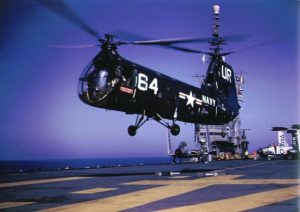 of NATC evaluation, the redesignated HUP-1 entered production in 1950. The initial order of 32 HUP-1s was followed by another order for 165 HUP-2s, which were fitted with the more powerful R-975-46, 550 hp engine. The HUPs were assigned to HU-1 and HU-2, and eventually replaced the less capable HO3Ss.
of NATC evaluation, the redesignated HUP-1 entered production in 1950. The initial order of 32 HUP-1s was followed by another order for 165 HUP-2s, which were fitted with the more powerful R-975-46, 550 hp engine. The HUPs were assigned to HU-1 and HU-2, and eventually replaced the less capable HO3Ss.
VX-3, HU-1 and HU-2 disestablished/established at Lakehurst
April 1, 1948. – VX-3 was disestablished. That same day Helicopter Utility Squadron One (HU-1) and Helicopter Utility Squadron Two (HU-2) were established at NAS Lakehurst, with many of VX-3 personnel making a lateral transfer to the new squadrons. HU-1 was moved to NAAS Miramar, San Diego, CA, shortly thereafter. The primary mission of both squadrons was to provide helicopter detachments to be deployed on ships of the Atlantic and Pacific fleets. HU-2 also took over the responsibility for helicopter pilot training. Naval Air Test Center, Patuxent River added rotary wing branch.
CNO Issued New Standards for Training Aviators as Helicopter Pilots
June 11, 1948. – The CNO issued new standards for training aviators as helicopter pilots and decreed that helicopter pilots previously trained by the Coast Guard or VX-3 would retain their qualification.
Piasecki Delivered 338 HUP Helicopters
January, 1949-Piasecki delivered 338 HUP helicopters to HU-2 (as XHUP-1, HUP 1-2S, H-25A). Last reported in inventory at VU-1, HU-1 on 08/31/64.
CNO Authorized all New Construction Cruisers to be accomodated for Helicopters
January 27, 1949-The Chief of Naval Operations authorized conversion of all new-construction cruisers to accommodate helicopters.
Longest Unescorted Helicopter Transcontinental Flight on Record
April 3, 1949. – LT Steward Graham and his crewman, AM2 Robert McAuliffe, completed the longest unescorted helicopter transcontinental flight on record. They flew a HO3S-1G from the Coast Guard Air Station, Elizabeth City, NC, to the Port Angeles Coast Guard Air Station in Washington State, via San Diego, CA, covering a distance of 3,750 miles in 57.6 flight-time hours over a period of ten and a half days, proving the helicopter’s suitability for extended operations.
The Last of the Observation Squadron, VO-2 Disestablished
April 5, 1949. – The disestablishing of the last of the observation squadron, VO-2, marked the end of one era and the beginning of another as a plan to use helicopters in place of fixed-wing aircraft aboard battleships and cruisers was put into effect, with the changeover scheduled for completion by 30 June. he disestablishing of the last of the observation squadrons, VO-2, marked the end of one era and the beginning of another as a plan to use helicopters in place of fixed-wing aircraft aboard battleships and cruisers was put into effect, with the changeover scheduled for completion by 30 June.
The First Use in the United States of a Pilot-Ejection Seat
August 9, 1949. – The first use in the United States of a pilot-ejection seat for an emergency escape, was made by Lieutenant J. L. Fruin of VF-171 from an F2H-1 Banshee while making over 500 knots in the vicinity of Walterboro, S.C.
Sikorsky helicopter, HO3S Long Distance Flight
November 30, 1949 – Lieutenant G. A. Rullo and M. D. Kembro, CAP, flew a Sikorsky helicopter, HO3S, from NAS Seattle to NAS Alameda in 10 hours and 50 minutes and unofficially bettered the existing distance record for helicopters with a flight of 755 miles
Kaman Aircraft Delivered Two K-225 Helicopters
March 1950. – Kaman Aircraft delivered two K-225 helicopters to NATC, Patuxent River, for test and evaluation. Successful results encouraged the Navy to place an order for new observation helicopters, designated HOK-1, to be used by the Marines in Korea.
